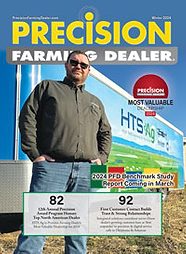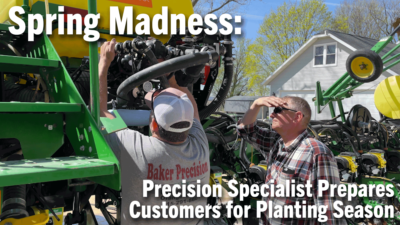Leveraging loyalty, experience and return on investment with technology can turn the pursuit of smaller farmers into profit for dealers.
It’s no secret that most precision farming dealers make their money selling technology to farm customers with large operations.
But as the market becomes saturated with precision products, the likelihood that dealers today will introduce farmers managing several thousand acres of row crops to their first yield monitor or auto-steering system is relatively small.
Some dealers are turning their attention to smaller-acre customers in their area, as an option for recruiting new precision business.
“Smaller acreage customers are finally getting into precision because it’s gotten to a price point where it’s more affordable for that type of farmer,” says P.J. McCullough, salesperson with McCullough Implement Co. in Watseka, Ill. “I do have a number of smaller-acre customers that I pursue aggressively with technology.”
As the primary precision salesperson at the single-store AGCO dealership, McCullough says he’s seen an increase in the 400-600 acre customers who are incorporating auto-steer and GPS systems into their operations.
One of the reasons is because even on smaller farms, customers are seeing the value in not having to concentrate on keeping their tractor, planter or combine driving in a straight line. McCullough recently installed an Outback guidance system on a customer’s John Deere 4440 tractor after the farmer learned an expensive lesson last spring while planting corn.
“On his John Deere planter, the wings crept forward and his vacuum pressure was only about half of what it should have been on the ends,” McCullough says. “He didn’t notice because he was so focused on steering and he ended up planting 30 acres at about 25,000 seed population, when it should have been 32,000.
“If he’d have had guidance, he’d have been able to watch his monitor and seeding rates a little closer and maybe caught that. That alone would have paid for the system.”
A lot of smaller-acre farmers have older tractors, which can require a little ingenuity to equip with modern precision technology, but McCullough says it’s often worth it. He’s even assembled adaptor kits for customers to outfit Allis Chalmers tractors with auto-steer systems.
“As long as it’s a hydraulically driven tractor, guidance is a tool these customers can use,” he says. “We can get them into a system for about $7,000 running off of a Wide Area Augmentation System (WAAS) and at that price point, it makes return on investment pretty easy.”
McCullough admits that smaller-acre farmers tend to be older and require a bit more “hand-holding” when it comes to set-up and maintenance of technology. But he says they are willing to spend money on the equipment and want their dealer to steer them in the right direction.
“A big advantage for us is that there’s a lot of loyalty with this customer base. They aren’t going to shop us with 14 other stores and nickel and dime us,” McCullough says. “It may take a little more time on my part, but these sales tend to generate more dollars per deal.”







Post a comment
Report Abusive Comment